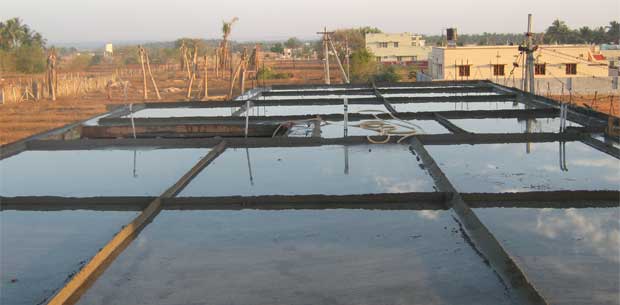
Curing is the process where the concrete surfaces are kept wet for a certain period after placing of concrete so as to promote the hardening of cement. It consists of a control of temperature and of the moisture movement from and into the concrete.
Contents:
Purposes of curing of concrete
Following are the objects or purposes of the curing of concrete:
- Curing protects the concrete surfaces from sun and wind.
- The presence of water is essential to cause the chemical action which accompanies the setting of concrete. Normally, there is an adequate quantity of water at the time of mixing to cause the hardening of concrete. But it is necessary to retain water until the concrete has fully hardened.
- The strength of concrete gradually increases with age, if curing is efficient. This increase in strength is sudden and rapid in early stages and it continues slowly for an indefinite period.
- By proper curing, the durability and impermeability of concrete are increased and shrinkage is reduced.
- The resistance of concrete to abrasion is considerably increased by proper curing.
Period of curing
This depends upon the type of cement and nature of work. For ordinary Portland cement, the curing period is about 7 to 14 days. If rapid hardening cement is used, the curing period can be considerably reduced.
Effects of improper curing
Following are the major disadvantages of improper curing of concrete:
- The chances of ingress of chlorides and atmospheric chemicals are very high.
- The compressive and flexural strengths are lowered.
- The cracks are formed due to plastic shrinkage, drying shrinkage and thermal effects.
- The durability decreases due to higher permeability.
- The frost and weathering resistances are decreased.
- The rate of carbonation increases.
- The surfaces are coated with sand and dust and it leads to lower the abrasion resistance.
The above disadvantages are more prominent in those parts of structures which are either directly exposed or those which have large surfaces compared to depth such as roads, canals, bridges, cooling towers, chimneys, etc. It is therefore necessary to protect the large exposed surfaces even before setting. Otherwise it may lead to a pattern of fine cracks.
Methods of curing
Following two factors are considered while selecting any mode of method of curing:
- The temperature should be kept minimum for dissipation of heat of hydration.
- The water loss should be prevented.
Thus all the methods of curing of concrete are derived from the basic principle of lowering of the surface temperatures and prevention of water evaporation. Several specialized curing techniques are employed in the modern construction work, but the most commonly employed methods of curing are as follows:
- Ponding with water.
- Covering concrete with wet jute bags.
- Covering concrete with water-proof paper of polythelene sheets and holding it in position.
- Intermittent spraying with water and continuous sprinkling of water.
- Applying curing compounds.

